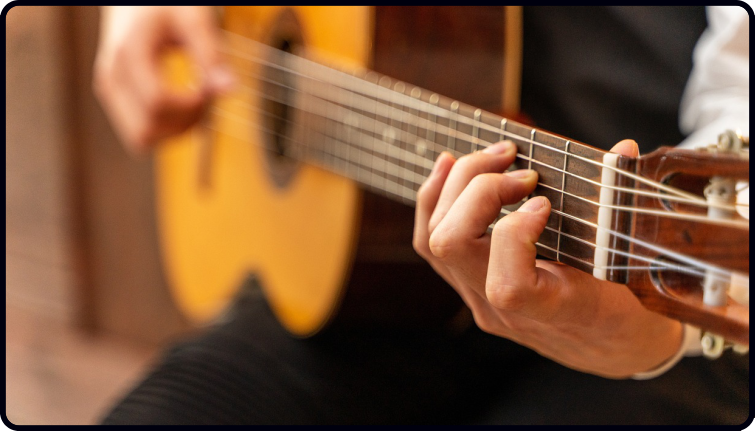I’m not a massive fan of teaching chords the conventional way.
The type I mean is where we play a chord such as a G, C, D…
But in the typical way, and strumming them over and over using one pattern.
This is the usual way guitar is taught to beginners, and when I see this…
It makes me want to reach through the screen, grab the teacher, and haul them off to an interrogation room.
Then crack my knuckles while looking quizzically, and in my best Starsky (or Hutch) impression say…
“Damn it, man, why are you teaching the guitar in the same old way as everyone else?”
I say this because…
How boring is it just strumming chords over and over using one pattern? (Unless you are a singer.)
How tricky is it to play chords and change smoothly between them? (For beginners, it is very tricky – especially when trying to make it all sound like music.)
And how many times do you see your favourite guitarists playing like this? (Most of my favourite guitarists do so much more than just strum chords.)
I’m not saying you shouldn’t ever do this sort of thing.
…But strumming chords in the same old way is like only listening to With the Beatles and never playing Revolver, Sgt. Pepper or the White Album.
There’s so much more to the Beatles than just that…
Just like there’s so much more to chords than just strumming open versions.
Playing chords in the conventional way can be fun, but to get the most out of that way of playing…
You either need to groove up the strumming, play some interesting picking patterns, embellish the chords, sing as you play, or jam with others.
…And I urge you to do all of the above.
But alongside this, I also urge you to have fun playing beautiful music in a solo setting.
…Where you let the guitar play the rich bass notes and the lovely melody notes.
Harmonising up and down the fretboard.
Giving your music real depth and allowing you to explore the fretboard.
I like to play and teach this using a simple technique which requires two fingers to play the chords and allows you to turn any chord into a simple and easy-to-play version.
This technique also brings out the beauty in each chord to give it maximum “flavour” so it sounds…
Stunningly beautiful!
There are just four very simple shapes that allow you to do all this.
I rarely see this technique taught, but when I do, some people have the penchant to complicate it.
I prefer to keep it simple using four basic shapes.
Don’t be fooled though, these shapes allow for hours of fun.
This technique is something I’ve taught in various ways in the past – particularly in the February 2021 and October 2022 lessons inside the Dan Thorpe Acoustic Academy.
…But for the month of January, we’re going deeper into this simple technique.
This way of playing chords has been used by musicians such as J.S. Bach and Ferdinando Carulli (two of my all-time favourite composers) and modern players too.
In the lesson, I’m showing you how to take two heavily used chord progressions and turn them into beautiful stripped-back versions that are, in my opinion, 10x more beautiful than the typical strummed versions you see everywhere else.
Anyway, enough teasing about this.
If you want this lesson, it’s part of the new Dan Thorpe Acoustic Academy lessons coming in January.
Normally I release the new lessons on January 1st, but this year I’ve decided to release them on the 2nd (with the 1st being a holiday for most of us).
That means you have until the 2nd to join and get this super fun lesson. Check it out here:
The Dan Thorpe Acoustic Academy
Dan Thorpe
Guitar Domination
P.S. This post was originally taken from Dan Thorpe’s private email list. To get blog posts like this sent to you which are full of great tips to make fingerpicking, strumming, and learning guitar more enjoyable (especially if you are over 40) join Dan’s list. It’s 100% free, HERE.


Add Comment